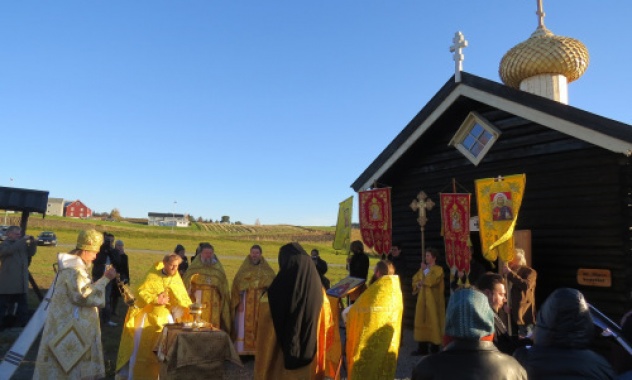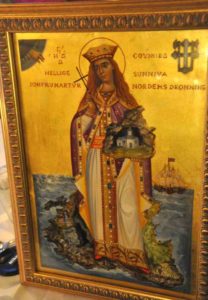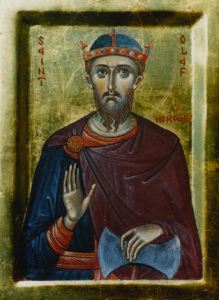Converting to Orthodoxy in Norway (It’s Been Done)
July 21, 2016 By Fr. John

A Romanian writer, Tudor is a graduate of the Faculty of Philosophy, University of Bucharest, Romania. He has published a number of articles related to philosophy and theology in different cultural and academic journals. His work focuses on the evolution of Orthodox spirituality in Western societies as well and he is going to publish a book of interviews with Westerners converted to Orthodoxy. In this article, he interviews Father Johannes Johansen, an Orthodox priest in Norway.
TP: First of all, please do tell us how you discovered Orthodoxy and why have you chosen the conversion to the Orthodox Church.
Fr. Johannes Johansen: By studying the Holy Bible. The Orthodox Church is the direct contuation of the Church that Christ himself founded on his holy apostles – the only possible Christian Church.
TP: What should we know about the Orthodox heritage of Norway, about the origins of Orthodoxy in Norway? When did actually appear the first Orthodox church in Norway?
 Fr. Johannes Johansen: Everybody thinks that Norway was Roman Catholic the first 500 years and then Lutheran/protestant. BUT this is a truth which has to be corrected. The Christianity started to influence “Norway” already in the 8th century, and in the 1000-c. We have the history with St. Sunniva of Selja (described in The Saga about King Olav Tryggvason) and then we have St. Olav Haraldson who eventually Christianized Norway (Stiklestad 1030), and a little later st. Hallvard in Oslo-aerea) – all of it BEFORE the schism between Rome and the other Orthodox Churches. That means the Church/Christianity in Norway in that first period was Orthodox Church/Christianity (not “roman-catholic”).
Fr. Johannes Johansen: Everybody thinks that Norway was Roman Catholic the first 500 years and then Lutheran/protestant. BUT this is a truth which has to be corrected. The Christianity started to influence “Norway” already in the 8th century, and in the 1000-c. We have the history with St. Sunniva of Selja (described in The Saga about King Olav Tryggvason) and then we have St. Olav Haraldson who eventually Christianized Norway (Stiklestad 1030), and a little later st. Hallvard in Oslo-aerea) – all of it BEFORE the schism between Rome and the other Orthodox Churches. That means the Church/Christianity in Norway in that first period was Orthodox Church/Christianity (not “roman-catholic”).
The second point is in the far north-east: In 16. century the holy missionary Trifon came from Novgorod and Christianized all the eastern “skolt” laps (saami) people. He built the chapel in Neiden in 1565 – still existing, and the tribe he Christianized are still Orthodox people and belonging to our parish.
The third point is 1920 – when a group of ablout 1000 Russian refugee came from Archangelsk/Murmansk to Norway and founded “The Orthodox Church (St. Nicholas Parish) in Norway”, still existing, my parish. The parish has after that expanded much.
TP: Can you please talk about the fullness of the Norwegian Orthodox tradition among the other orthodox traditions in Eastern and Central Europe? I don’t know if this is a right question, but I am thinking about the fact that there should be a some kind of fullness as I have mentioned above.
Fr. Johannes Johansen: In fact, we can not yet talk about a Norwegian Orthodox cultural tradition, but we can say that it is in the process of being formed. First of all the language: we are using more and more norwegian (in stead of church-slavonic) because of the international composition of members in the parishes. We are also combining Russian/slavonic music with the byzantine. We have published a great range of books, and translated most of the liturgical texts.
TP: Who are the most important saints celebrated in the Norwegian Orthodox Church?
 Fr. Johannes Johansen: We do not say “The Norwegian Orthodox Church” but “The Orthodox Church in Norway” (an important difference). The most important saints for Orthodoxy in Norway are: St. Sunniva, St. Olav, St. Hallvard and St. Trifon, the apostles Peter and Paul. St. Seraphim of Sarov and St. Nicholas.
Fr. Johannes Johansen: We do not say “The Norwegian Orthodox Church” but “The Orthodox Church in Norway” (an important difference). The most important saints for Orthodoxy in Norway are: St. Sunniva, St. Olav, St. Hallvard and St. Trifon, the apostles Peter and Paul. St. Seraphim of Sarov and St. Nicholas.
TP: What can you say about the dialogue between the Norwegian Orthodox Church and the other local and traditional orthodox churches such as the Russian, the Greek or the Serbian one?
Fr. Johannes Johansen: We try to have good and friendly relations to them. But a great difference between them and us, is that they are very nationalistic, while we welcome people of all nationalities, for us the Orthodox faith and Tradition is the only thing that matters.
TP: Which are the most important Orthodox churches and monasteries in Norway?
St Nicholas Church in Oslo. St. Georges chapel in Neiden. St. Trifon monastery in Hurdal.
TP: I also wish to find out more information about the written books concerning the Orthodoxy in Norway. So, what books should we read so that we can better discover the Orthodox Church in Norway?
Fr. Johannes Johansen: In 2003 we published a book of the history of the parish of St Nicholas (the first and oldest parish in Norway) in Oslo. Now we are ready to publish a book about the monastery of St. Trifon also.
TP: Which is the main role and importance of the Orthodox Church in the Norwegian society at this moment?
Fr. Johannes Johansen: We try to defend traditional Christian dogma and moral standards againt modernism and secularisation. We are active in oecumenical movement to witness about Orthodoxy.
Fr. Johannes Johansen’s parish website can be found here.
This interview is one of many that will be published in the book “The rediscovery of Orthodox heritage of the West” by Tudor Petcu, containing interviews with different Westerners converted to Orthodoxy. It will be published in two volumes and the first one will appear by the end of this year.
A Romanian writer, Tudor is a graduate of the Faculty of Philosophy, University of Bucharest, Romania. He has published a number of articles related to philosophy and theology in different cultural and academic journals. His work focuses on the evolution of Orthodox spirituality in Western societies as well and he is going to publish a book of interviews with Westerners converted to Orthodoxy. In this article, he interviews Father Johannes Johansen, an Orthodox priest in Norway.
TP: First of all, please do tell us how you discovered Orthodoxy and why have you chosen the conversion to the Orthodox Church.
Fr. Johannes Johansen: By studying the Holy Bible. The Orthodox Church is the direct contuation of the Church that Christ himself founded on his holy apostles – the only possible Christian Church.
TP: What should we know about the Orthodox heritage of Norway, about the origins of Orthodoxy in Norway? When did actually appear the first Orthodox church in Norway?
 Fr. Johannes Johansen: Everybody thinks that Norway was Roman Catholic the first 500 years and then Lutheran/protestant. BUT this is a truth which has to be corrected. The Christianity started to influence “Norway” already in the 8th century, and in the 1000-c. We have the history with St. Sunniva of Selja (described in The Saga about King Olav Tryggvason) and then we have St. Olav Haraldson who eventually Christianized Norway (Stiklestad 1030), and a little later st. Hallvard in Oslo-aerea) – all of it BEFORE the schism between Rome and the other Orthodox Churches. That means the Church/Christianity in Norway in that first period was Orthodox Church/Christianity (not “roman-catholic”).
Fr. Johannes Johansen: Everybody thinks that Norway was Roman Catholic the first 500 years and then Lutheran/protestant. BUT this is a truth which has to be corrected. The Christianity started to influence “Norway” already in the 8th century, and in the 1000-c. We have the history with St. Sunniva of Selja (described in The Saga about King Olav Tryggvason) and then we have St. Olav Haraldson who eventually Christianized Norway (Stiklestad 1030), and a little later st. Hallvard in Oslo-aerea) – all of it BEFORE the schism between Rome and the other Orthodox Churches. That means the Church/Christianity in Norway in that first period was Orthodox Church/Christianity (not “roman-catholic”).The second point is in the far north-east: In 16. century the holy missionary Trifon came from Novgorod and Christianized all the eastern “skolt” laps (saami) people. He built the chapel in Neiden in 1565 – still existing, and the tribe he Christianized are still Orthodox people and belonging to our parish.
The third point is 1920 – when a group of ablout 1000 Russian refugee came from Archangelsk/Murmansk to Norway and founded “The Orthodox Church (St. Nicholas Parish) in Norway”, still existing, my parish. The parish has after that expanded much.
TP: Can you please talk about the fullness of the Norwegian Orthodox tradition among the other orthodox traditions in Eastern and Central Europe? I don’t know if this is a right question, but I am thinking about the fact that there should be a some kind of fullness as I have mentioned above.
Fr. Johannes Johansen: In fact, we can not yet talk about a Norwegian Orthodox cultural tradition, but we can say that it is in the process of being formed. First of all the language: we are using more and more norwegian (in stead of church-slavonic) because of the international composition of members in the parishes. We are also combining Russian/slavonic music with the byzantine. We have published a great range of books, and translated most of the liturgical texts.
TP: Who are the most important saints celebrated in the Norwegian Orthodox Church?
 Fr. Johannes Johansen: We do not say “The Norwegian Orthodox Church” but “The Orthodox Church in Norway” (an important difference). The most important saints for Orthodoxy in Norway are: St. Sunniva, St. Olav, St. Hallvard and St. Trifon, the apostles Peter and Paul. St. Seraphim of Sarov and St. Nicholas.
Fr. Johannes Johansen: We do not say “The Norwegian Orthodox Church” but “The Orthodox Church in Norway” (an important difference). The most important saints for Orthodoxy in Norway are: St. Sunniva, St. Olav, St. Hallvard and St. Trifon, the apostles Peter and Paul. St. Seraphim of Sarov and St. Nicholas.TP: What can you say about the dialogue between the Norwegian Orthodox Church and the other local and traditional orthodox churches such as the Russian, the Greek or the Serbian one?
Fr. Johannes Johansen: We try to have good and friendly relations to them. But a great difference between them and us, is that they are very nationalistic, while we welcome people of all nationalities, for us the Orthodox faith and Tradition is the only thing that matters.
TP: Which are the most important Orthodox churches and monasteries in Norway?
St Nicholas Church in Oslo. St. Georges chapel in Neiden. St. Trifon monastery in Hurdal.
TP: I also wish to find out more information about the written books concerning the Orthodoxy in Norway. So, what books should we read so that we can better discover the Orthodox Church in Norway?
Fr. Johannes Johansen: In 2003 we published a book of the history of the parish of St Nicholas (the first and oldest parish in Norway) in Oslo. Now we are ready to publish a book about the monastery of St. Trifon also.
TP: Which is the main role and importance of the Orthodox Church in the Norwegian society at this moment?
Fr. Johannes Johansen: We try to defend traditional Christian dogma and moral standards againt modernism and secularisation. We are active in oecumenical movement to witness about Orthodoxy.
Fr. Johannes Johansen’s parish website can be found here.
This interview is one of many that will be published in the book “The rediscovery of Orthodox heritage of the West” by Tudor Petcu, containing interviews with different Westerners converted to Orthodoxy. It will be published in two volumes and the first one will appear by the end of this year.










